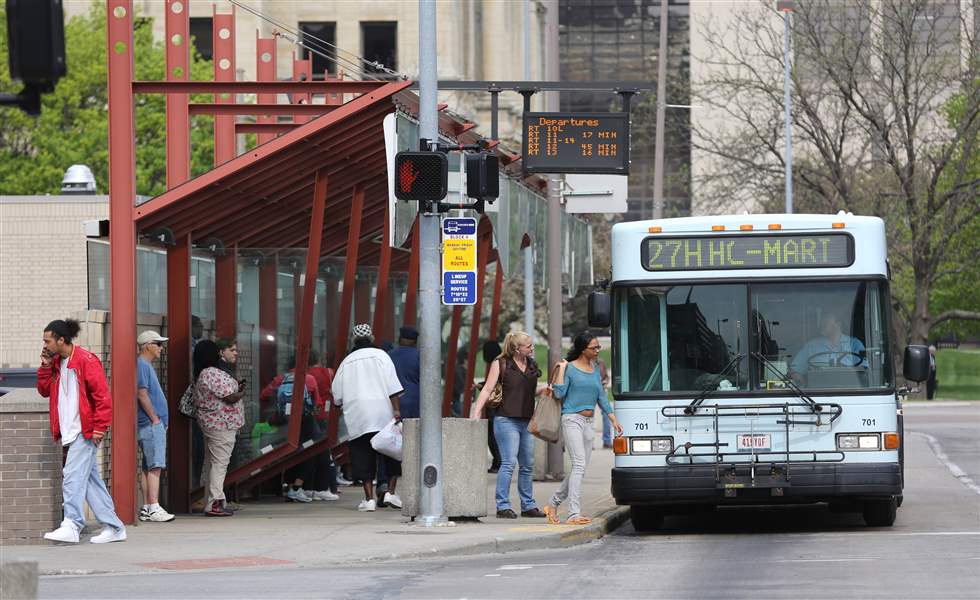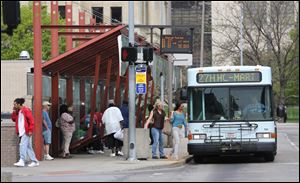
FEATURED EDITORIAL
TARTA faces uphill push in bid to change funding model
7/9/2017
The TARTA bus station on Jackson Street at Huron Street in downtown Toledo. The transit authority has its work cut out for it in efforts to sell a switch in the way it is funded.
THE BLADE
Buy This Image
The Toledo Area Regional Transit Authority wants a new form of funding that will bring it more dollars, and its executive director is lobbying Toledo’s neighboring communities to get the new initiative before voters in November.
The authority has its work cut out for it.

The TARTA bus station on Jackson Street at Huron Street in downtown Toledo. The transit authority has its work cut out for it in efforts to sell a switch in the way it is funded.
TARTA proposes to eliminate the property tax that funds it in seven communities. Instead, a countywide half-cent sales tax would take its place. The additional sales tax would generate about $30 million a year, replacing a property tax that now generates roughly $13 million a year. The sales tax also would be collected in Rossford, which is in Wood County but is a member of TARTA.
The bus system needs approval from its member communities to put the question on the Nov. 7 ballot. And, so far, the campaign is not going well.
RELATED CONTENT: Councilman calling police chief to get speeding ticket “fixed” looks bad because it is bad ■ More Blade editorials
Officials in these communities have been skeptical and noncommittal. For one thing, sales taxes are generally considered to be “regressive,” meaning that they hit the poor hard because the money is out-of-pocket and not based on property, which the poor have little of. For another, this plan would give Lucas County, which is already at the top of the scale in Ohio, one of the highest sales-tax rates in the state. That might slow economic development when it is just coming alive. Finally, under the plan, TARTA would raise its money from the new tax and then rebate what it deems excess revenue to the partner communities to pay for infrastructure needs and the like — an approach that is novel, if not bizarre and dubious as a matter of public policy and public administration.
The Toledo Regional Chamber of Commerce came out against the plan last week.
But there is another reason TARTA will have a hard time making its case, and you hear it from progressives, longtime Democrats, and advocates for the city as much as from anyone else: Before TARTA asks for more money, many people ask, shouldn’t it get itself in better order?
Shouldn’t TARTA improve its vehicles and service, upgrade its management and board, and present a vision for the future before it asks for more revenue?

Talk to anyone — activists, public policy makers, riders — no one has much good to say about TARTA in its current state. The buses are old and uncomfortable. They are too big. They are mostly empty. Ridership has steadily declined through the years. The routes are not well publicized. The system seems to be created for the 1970s, not today.
Middle-class people and young people do not ride the buses in Toledo and do not want to. Our buses are ghettos on wheels. That is the opposite of what good modern mass-transit systems are and need to be.
Millennials want to live in the downtown areas of cities, and they want, specifically, today, to live in downtown Toledo. A system designed around them and their needs will attract and carry the poor. A system designed only around the very poor will not attract millennials.
Most people in greater Toledo will tell you that TARTA needs a complete overhaul, the result sought being an urban mass transit system for the 21st century.
If TARTA wants to build support for new funding, it needs to do what the 22nd Century Committee did for downtown Toledo: Invite the public to talk about what it would like to see from a mass transit system and invite out-of-town experts to talk about modern, innovative systems in other cities. There are some good stories to tell: Dallas has built the largest light-rail system in the Southwest and is still building. The “T” in Pittsburgh has opened up the formerly moribund North Shore and united it with downtown.
Suppose the vital, new urban downtown Toledo, now emerging, had some form of efficient light rail or trolley sub-system to carry people from one entertainment venue to another downtown and then to UpTown and the hospital area.
We need to dream a bit, and talk about it. We need to have a community-wide dialogue about how mass transit fits into the new Toledo. How do we make it not only efficient, but friendly and “cool”? It is none of those things now. Pittsburgh’s system is.
And how do we do all this to scale — in a way that fits this city and is affordable?
We have not had that conversation. And that is what makes our TARTA tax plan an uphill proposition. Our neighboring towns are likely to say: What’s new? What’s the plan? Where is the vision?
Until it can answer these and other questions TARTA is likely, like Lucy Ricardo, to have “some ’splaining to do.” The partner communities, and the voters, may well see more money for the same old, same old, as an unpersuasive proposition.